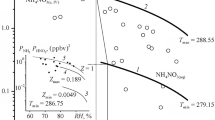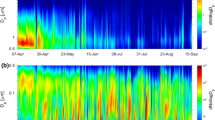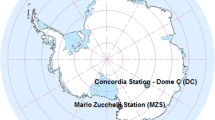A case study for the ion–aerosol interactions is presented from the simultaneous measurements of mobility spectra of atmospheric ions in the mobility range of 2.29 to 2.98 × 10 − 4 cm2 V − 1 s\(^{-1}\)(diameter range 0.41–109 nm) and of size distribution of atmospheric aerosol particles in the size ranges of 4.4–700 nm and 500–20,000 nm diameters made at Maitri (70°45′52′ ′S, 11°44′2.7′ ′E; 130 m above mean sea level), Antarctica, on two days January 17 and February 18, 2005, with contrasting meteorological conditions. In contrast to January 17, on February 18, winds were stronger from the morning to noon and lower from the noon to evening, atmospheric pressure was lower, cloudiness was more, the land surface remained snow-covered after a blizzard on February 16 and 17 and the airmass over Maitri, descended from an altitude of ~3 km after an excursion over ocean. On these days mobility spectra showed two modes, corresponding to intermediate ions and light large ions and an indication of additional one/two maxima for small/cluster ions and heavy large ions. The small ions generated by cosmic rays, and the nucleation mode particles generated probably by photochemical reactions grew in size by condensation of volatile trace gases on them and produced the cluster and intermediate ion modes and the Aitken particle mode in ion/particle spectra. Particles in the size range of 9–26 nm have been estimated to grow at the rate of 1.9 nm h − 1 on February 18, 2005. Both, ions and aerosol particles show bimodal size distributions in the 16–107 nm size range, and comparison of the two size distributions suggests the formation of multiple charged ions. Attachment of small ions to particles in this bimodal distribution of Aitken particles together with the formation of multiple charged ions are proposed to result in the light and heavy large ion modes. Growth of the nucleation mode particles on February 18, 2005 is associated with the passage of the airmass over ocean. In contrast, though the ion size distributions were not much different, the aerosol size distributions did not show a dominant peak for the formation and growth of nucleation mode particles on January 17. More measurements are needed before the conclusion of this case study is generalized.
Similar content being viewed by others
References
Blackwood O 1920 The evidence of homogenous groups of larges ions; Phys. Rev. 16 85–101.
Bricard J 1949 L’equilibre ionique de la bassc atmosphere; J. Geophys. Res. 54 39–52.
Bricard J 1962 La fixation de petits ions atmospheriques sur les aerosols ultra-fins; Geofis. Pura Appl. 51 237–242.
Dhanorkar S and Kamra A K 1991 Measurement of mobility spectrum and concentration of all atmospheric ions with a single apparatus; J. Geophys. Res. 96 18,671–18,678.
Dhanorkar S and Kamra A K 1993 Diurnal variations of the mobility spectrum of ions and size distribution of fine aerosols in the atmosphere; J. Geophys. Res. 98 2639–2650.
Dhanorkar S and Kamra A K 2001 Effect of coagulation on the particle charge distribution and air conductivity; J. Geophys. Res. 106 12,055–12,065.
Dhanorkar S and Kamra A K 2003 Effect of coagulation on the asymmetric charging of aerosols; Atmos. Res. 66 159–173.
Draxler R R and Rolph G D 2003 HYSPLIT (Hybrid Single- Particle Lagrangian Integrated Trajectory) Model access via NOAA ARL READY website (http://www.arl.noaa.gov/ready/hysplit4.html); NOAA Air Resources Laboratory, Silver Spring, MD.
Gagne S, Laakso L, Petaja T, Kerminen V-M and Kulmala M 2008 Analysis of one year of ion-DMPS data from the SMEAR II station. Finland; Tellus 60B 318–329.
Hirsikko A, Bergman T, Laakso L, Riipinen M Dal Maso, Horrak U and Kulmala M 2007 Identification and classification of the formation of intermediate ions measured in boreal forest; Atmos. Chem. Phys. 7 201–210.
Hoppel W A 1977 Ion aerosol attachment coefficients and the diffusional charging of aerosols; In: Electrical Processes in Atmospheres (eds) Dolezalek H and Reiter R (Darmstadt: Dr. Dietrich Steinkopff Verlag) 60–69.
Hoppel W A, Fitzgerald J W, Frick G M, Larson R E and Mack E J 1990 Aerosol size distribution and optical properties found in marine boundary layer over the Atlantic Ocean; J. Geophys. Res. 95 3659–3686.
Horrak U, Iher H, Luts A, Salm J and Tammet H 1994 Mobility spectrum of air ions at Takhuse observatory; J. Geophys. Res. 99 10,697–10,700.
Horrak U, Mirme A, Salm J, Tamm E and Tammet H 1998 Air ion measurements as a source of information about atmospheric aerosols; Atmos. Res. 46 233–242.
Horrak U, Salm J and Tammet H 2000 Statistical characteristic of air ion mobility spectra at Tahkuse Observatory: Classification of air ion; J. Geophys. Res. 105 9291–9302.
Horrak U, Salm J and Tammet H 2003 Diurnal variation in the concentration of air ions of different mobility classes in a rural area; J. Geophys. Res. 108 4653, doi: 10.1029/2002JD003240.
Horrak U, Aalto P P, Salm J, Komsaare K, Tammet H, Makel J M, Laakso L and Kulmala M 2008 Variation and balance of positive air ion concentrations in a boreal forest; Atmos. Chem. Phys. 8 655–675.
Israel H 1970 Atmospheric Electricity, Vol. 1. Israel Program for Scientific Translations, Jerusalem, 317 pp.
Khlystov A, Stanier C and Pandis S N 2004 An algorithm for combining electrical mobility and aerodynamic size distributions data when measuring ambient aerosol; Aerosol Sci. Tech. 38(S1) 229–238.
Kirkby J 2007 Cosmic rays and climate; Surv. Geophys. 28 333–375, doi: 10.1007/s10712-008-9030-6.
Kojima H 1984 Relation between intermediate ions and meteorological factor; Res. Let. Atmos. Electr. 4 49–53.
Komppula M, Vana M, Kerminen V-M, Lihavainen H, Viisanen Y, H orrak U, Komsaare K, Tamm E, Hirsikko A, Laakso L and Kulmala M 2007 Size distributions of atmospheric ions in the Baltic Sea region; Boreal Env. Res. 12 323–336.
Komsaare K, H orrak U, Tammet H, Siingh D, Vana M, Hirsikko A and Kulmala M 2007 Classification of intermediate air ion formation events at Tahkuse Observatory, Estonia; Proceeding of 13th International Conference on Atmospheric Electricity, Beijing, China, 13–17 August, 2007.
Koponen I K, Virkkula A, Hillamo R, Kerminen V-M and Kulmala M 2003 Number size distributions and concentrations of the continental summer aerosols in Queen Maud Land, Antarctic; J. Geophys. Res. 108(D18) 4587, doi: 10.1029/2003JD003614.
Kulmala M, Vehkamaki H, Petäjä T, Maso M Dal, Lauri A, Kerminen V-M, Birmili W and McMurry P 2004 Formation and growth rates of ultrafine atmospheric particles: A review of observations; J. Aerosol Sci. 35(2) 143–176.
Kulmala M, Riipinen I, Sipilä M, Manninen H E, Petäjä T, Junninen Hi, Maso M Dal, Mordas G, Mirme A, Vana M, Hirsikko A, Laakso L, Harrison Roy M, Hanson I, Leung C, Lehtinen K E J and Kerminen Veli-Matti 2007 Toward direct measurements of atmospheric nucleation; Science 318 89–91.
Lee S-H, Young L-H, Benson D R, Suni T, Kulmala M, Junninen H, Campos T L, Rogers D C and Jensen J 2008 Observations of nighttime new particle formation in the troposphere; J. Geophys. Res. 113 D10210, doi: 10.1029/2007JD009351.
Meters S, Galgon D, Schwirn K, Nowak A, Lehmann K, Massling A, Wiedensohler A and Wieprecht W 2005 Evolutions of particle concentration and size distribution observed upwind, inside and downside hill cap clouds at connected flow condition during FEBUKO; Atmos. Environ. 39 4233–4245.
Misaki M 1961 A method of measuring the ion spectrum; Papers Meteorol. Geophys. Tokyo 1 313–318.
Misaki M 1964 Mobility spectrums of large ions in the New Mexico semi-desert; J. Geophys. Res. 69 3309–3318.
Misaki M, Ohtagaki M and Kanazawa I 1972 Mobility spectrometry of the atmospheric ions in relations to atmospheric pollution; Pure Appl. Geophys. 100 133–145.
Nagato K and Ogawa T 1998 Evaluation of tropospheric ions observed by an ions mobility spectrometer with a drift tube; J. Geophys. Res. 103 13,917–13,925.
Ondracek J, Zdimal V, Smolik J and Lazaridis M 2009 A merging algorithm for aerosol size distribution from multiple instruments; Water Air and Soil Pollution 199 219–233, doi: 10.1007/s11270-008-9873-y.
Pant V, Despande C G and Kamra A K 2008 On the aerosol number concentration–wind speed relationship during a severe cyclonic storm over South Indian Ocean; J. Geophys. Res. 113 D02206, doi: 10.1029/2006JD008035.
Pant V, Siingh D and Kamra A K 2010 Concentrations and size distributions of aerosol particles at Maitri during the passage of cyclonic storms revolving around the continent of Antarctica; J. Geophys. Res. 115 D17202, doi: 10.1029/2009JD013481.
Pant V, Siingh D and Kamra A K 2011 Size distribution of atmospheric aerosols at Maitri, Antarctica; Atmos. Environ. 45 5138–5149, doi: 10.1016/j.atmosenv.2011.06.028.
Park J, Sakurai H, Vollmers K and Mcmurry P H 2004 Aerosol size distribution measured at South Pole during ISCAT; Atmos. Environ. 38 5493–5500.
Peters T M, Chein H M, Lundgren D A and Keady P B 1993 Comparison and combination of aerosol size distributions measured with a low pressure impactor, differential mobility particle sizer, electrical aerosol analyzer, and aerodynamic particle sizer; Aerosol Sci. Technol. 19 396–405.
Raes F, Van Dingenen R, Vignati E, Wilson J, Putaud J P, Seinfeld J H J and Adams P 2000 Formation and cycling of aerosol in the global troposphere; Atmos. Environ. 34 4215–4240.
Ramachandran T V and Balani M C 1995 Report on the participation by the Bhabha Atomic Research Centre in the Tenth Indian Expedition to Antarctica, Scientific Report on Tenth Indian Expedition to Antarctica; Tech. Publ., Dept. of Ocean Development, Govt. of India, New Delhi, India, 8 159–180.
Rycroft M J, Israelsson S and Price C 2000 The global atmospheric electric circuit, solar activity and climate change; J. Atmos. Solar Terr. Phys. 62 1563–1576.
Siingh D and Singh R P 2010 The role of cosmic rays on the Earth’s atmosphere; Pramana – J. Phys. 74 153–168.
Siingh D, Pawar S D, Gopalakrishnan V and Kamra A K 2005a Measurements of ion concentrations and conductivity over the Arabian Sea during the ARMEX; J. Geophys. Res. 110 D18207, doi: 10.1029/2005JD005765.
Siingh D, Singh R P, Kamra A K, Gupta P N, Singh R, Gopalakrishnan V and Singh A K 2005b Review of electromagnetic coupling between the Earth’s atmosphere and space environment; J. Atmos. Solar Terr. Phys. 67 637–658.
Siingh D, Pant V and Kamra A K 2007a Measurements of positive ions and air-Earth current density at Maitri, Antarctica; J. Geophys. Res. 112 D13212, doi: 10.1029/2006JD008101.
Siingh D, Gopalakrishnan V, Singh R P, Kamra A K, Singh S, Pant V, Singh R and Singh A K 2007b The atmospheric global electric circuit: An overview; Atmos. Res. 84 91–110.
Siingh D, Singh A K, Patel R P, Singh R P, Venadhari B and Mukherjee M 2008 Thunderstorm, lightning, sprites and magnetospheric whistler mode radio wave; Surv. Geophys. 29 499–551, doi: 10.1007/s10712-008-9053-z.
Siingh D, Singh R P, Singh A K, Kulkarni M N, Gautam A S and Singh Abhay K 2011 Solar activity, lightning and climate; Surv. Geophys., doi: 10.1007/s10712-011-9127-1, published online 21 May 2011.
Singh D K, Singh R P and Kamra A K 2004 The electrical environment of the Earth’s atmosphere: A review; Space Sci. Rev. 113 375–408.
Singh A K, Siingh D and Singh R P 2011 Impact of galactic cosmic rays on the Earth’s atmosphere and human health; Atmos. Environ. 45 3805–3815, doi: 10.1016/j.atmosenv.2011.04.027.
Tammet H 1992 Comparison of model distributions of aerosol particles sizes; Acta et. Comm. Uni. Tartuensis 947 136–149.
Tammet H 1995 Size and mobility distribution of nanometer particles, cluster and ions; J. Aerosol Sci. 26 459–475.
Tinsley B A 2000 Influence of solar wind on the global electric circuit, and inferred effects on the cloud microphysics, temperature, and dynamics in troposphere; Space Sci. Rev. 94 231–258.
Tinsley B A 2008 The global atmospheric electric circuit and its effects on cloud microphysics; Rep. Prog. Phys. 71(066801):31, doi: 10.1088/0034-4885/71/6/066801.
Vana M, Kulmala M, Maso M Dal, Horrak U and Tamm E 2004 Comparative study of nucleation mode aerosol particles and intermediate ions formation events at three sites; J. Geophys. Res. 109 D17201, doi: 1029/2003JD004413.
Vana M, Ehn M, Petaja T, Vuollekoski H, Aalto P, de Leeuw G, Ceburnis D, O’Dowd Colin D and Kulmala M 2008 Characteristic features of air ions at Mace Head on the west coast of Ireland; Atmos. Res. 90 278–286.
Vartiainen E, Kulmala M, Ehn M, Hirsikko A, Junninen H, Petäjä T, Sogacheva L, Kuokka S, Hillamo R, Skorokhod A, Belikov I, Elansky N and Kerminen V-M 2007 Ion and particle number concentrations and size distributions along the Trans-Siberian railroad; Boreal Env. Res. 12 375–396.
Virkkula A, Hirsikko A, Vana M, Aalto Pasi P, Hillamo R and Kulmala M 2007 Charged particle size distribution and analysis of particle formation events at Finnish Antarctic research station, Aboa; Borel Environ. Res. 12 397–408.
Wiedensohler A et al 1997 Night-time formation and occurrence of new particles associated with orographic clouds; Atmos. Environ. 31 2545–2559.
Whipple E C 1960 An improved technique for obtaining ion mobility distributions; J. Geophys. Res. 65 3679– 3684.
Yu F 2010 Ion-mediated nucleation in the atmosphere: Key controlling parameters, implications, and look-up table; J. Geophys. Res. 115 D03206, doi: 10.1029/2009JD012630.
Williams E R 2009 The global electrical circuit: A review; Atmos. Res. 91 140–152, doi: 10.1016/j.atmosres.2008.05. 018.
Author information
Authors and Affiliations
Corresponding author
Rights and permissions
About this article
Cite this article
SIINGH, D., PANT, V. & KAMRA, A.K. The ion–aerosol interactions from the ion mobility and aerosol particle size distribution measurements on January 17 and February 18, 2005 at Maitri, Antarctica – A case study. J Earth Syst Sci 120, 735–754 (2011). https://doi.org/10.1007/s12040-011-0102-5
Received:
Revised:
Accepted:
Published:
Issue Date:
DOI: https://doi.org/10.1007/s12040-011-0102-5




